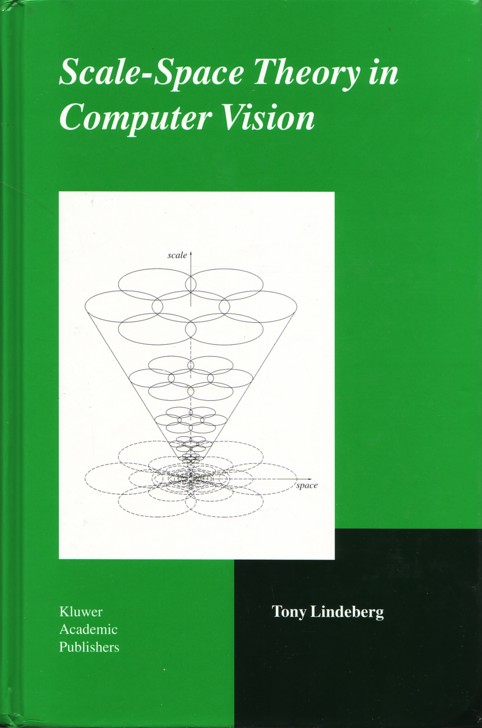
Scale-Space Theory in Computer Vision
-
Tony Lindeberg
KTH Royal Institute of Technology
-
Stockholm, Sweden
Contents
- Introduction and overview (1)
- Theory of a visual front-end
- Goal
- The nature of the problem
- Scale-space representation
- Philosophies and ideas behind the approach
- Relations to traditional numerical analysis
- Organization of this book
Part I: Basic scale-space theory
-
Linear scale-space and related multi-scale representations (31)
- Early multi-scale representations
- Quad-tree
- Pyramid representations
- Scale-space representation and scale-space properties
- Uniqueness of scale-space representation
- Summary and retrospective
- Wavelets
- Regularization
- Relations between different multi-scale representations
-
Scale-space for 1-D discrete signals (61)
- Scale-space axioms in one dimension
- Properties of scale-space kernels
- Kernel classification
- Axiomatic construction of discrete scale-space
- Axiomatic construction of continuous scale-space
- Numerical approximations of continuous scale-space
- Summary and discussion
- Conclusion: Scale-space for 1-D discrete signals
-
Scale-space for N-D discrete signals (101)
- Scale-space axioms in higher dimensions
- Axiomatic discrete scale-space formulation
- Parameter determination
- Summary and discussion
- Possible extensions
-
Discrete derivative approximations with scale-space properties (123)
- Numerical approximation of derivatives
- Scale-space derivatives
- Discrete approximation of scale-space derivatives
- Computational implications
- Kernel graphs
- Summary and discussion
-
Feature detection in scale-space (149)
- Differential geometry and differential invariants
- Experimental results: Low-level feature extraction
- Feature detection from differential singularities
- Selective mechanisms
Part II: The scale-space primal sketch: Theory
-
The scale-space primal sketch (165)
- Grey-level blob
- Grey-level blob tree
- Motivation for introducing a multi-scale hierarchy
- Scale-space blob
- Scale-space blob tree
- Grey-level blob extraction: Experimental results
- Measuring blob significance
- Resulting representation
-
Behaviour of image structures in scale-space: Deep structure (187)
- Trajectories of critical points in scale-space
- Scale-space blobs
- Bifurcation events for critical points: Classification
- Bifurcation events for grey-level blobs and scale-space blobs
- Behaviour near singularities: Examples
- Relating differential singularities across scales
- Density of local extrema as function of scale
- Summary
-
Algorithm for computing the scale-space primal sketch (227)
- Grey-level blob detection
- Linking grey-level blobs into scale-space blobs
- Basic blob linking algorithm
- Computing scale-space blob volumes
- Potential improvements of the algorithm
- Data structure
Part III: The scale-space primal sketch: Applications
-
Detecting salient blob-like image structures and their scales (249)
- Motivations for the assumptions
- Basic method for extracting blob structures
- Experimental results
- Further treatment of generated blob hypotheses
- Properties of the scale selection method
- Additional experiments
-
Guiding early visual processing with qualitative scale and region information (271)
- Guiding edge detection with blob information
- Automatic peak detection in histograms
- Junction classification: Focus-of-attention
- Example: Analysis of aerosol images
- Other potential applications
-
Summary and discussion (307)
- Scale-space experiences
- Relations to previous work
- Grey-level blobs
- Laplacian sign blobs
- Invariance properties
- Alternative approaches and further work
- Conclusions
Part IV: Scale selection and shape computation
in a visual front-end
- Scale selection for differential operators (317)
- Basic idea for scale selection
- Proposed method for scale selection
- Blob detection
- Junction detection
- Edge detection
- Discrete implementation of normalized derivatives
- Interpretation in terms of self-similar Fourier spectrum
- Summary and discussion
-
Direct computation of shape cues by scale-space operations (349)
- Shape-from-texture: Review
- Definition of an image texture descriptor
- Deriving shape cues from the second moment matrix
- Scale problems in texture analysis
- Computational methodology and experiments
- Spatial selection and blob detection
- Estimating surface orientation
- Experiments
- Summary and discussion
-
Non-uniform smoothing (383)
- Non-linear diffusion: Review
- Linear shape-adapted smoothing
- Affine scale-space
- Definition of an affine invariant image texture descriptor
- Outlook
Appendix:
-
Technical details (395)
- Implementing scale-space smoothing
- Polynomials satisfying the diffusion equation
-
Bibliography (399)
-
Index (415)
Responsible for this page:
Tony Lindeberg
|

